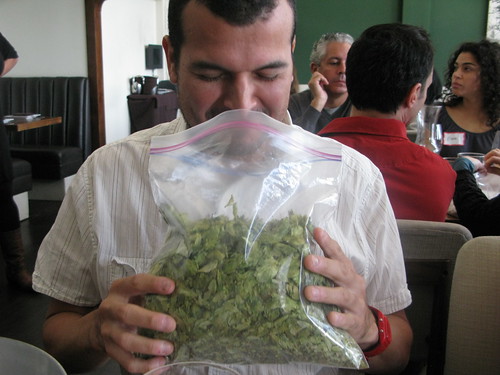This past Saturday, I was fortunate enough to attend Beer School hosted by Beer Chicks Christina Perozzi and Hallie Beaune at Rustic Canyon Wine Bar in Santa Monica. We went through 13 beers learning about the variety of flavors, distinguishing characteristics, what hops and barley look like, etc. But here are some things I took away from the class and the Beer Chicks’ book, The Naked Pint. Stuff that, sure you probably already knew, but were frankly news to me since I’m not a beer connoisseur.
As many types of beers there are out there, there are actually only two categories they are separated into: ale and lager. The quick way to tell the difference is if you sniff the beer and don’t smell anything, it’s a lager since ales are the ones that are aromatic.
When in Germany, do not put a slice of lemon on your glass of Hefeweizen. That’s a sure way to piss off the Germans. Hefs have an aroma of bananas and cloves and a slice of lemon would totally kill that.
Although stouts and porters are dark doesn’t mean they have higher alcohol content or more calories. A St. Bernardus Witbier has 5.50% ABV versus Guinness’ 4.20% ABV. And stouts/porters do seem heartier but they actually are worth less Weight Watcher points than, say, a Sierra Nevada Pale Ale.
Here are the reasons why you have to pour Guinness a very specific way:
- At bars Guinness has its own specialized tap that’s hooked up to a nitrogenated tank which creates nitrogen bubbles that are really tiny and stick together and make for that creamy-looking texture. The bubbles and beer need to settle for a bit.
- Beer in nitrogenated tanks are meant to mimick the creamy mouthfeel of cask ales.
- The perfect pour of Guinness should create a two-finger thick head on it so you can enjoy that creaminess and get enough beer.
- Indian Pale Ales aka IPAs are actually not all nasty-tasting. My problem with them before is that I didn’t like their bitterness and the ones I’ve had have only tasted like pine needles. At beer school, I tried both the Ranger IPA and the Inversion IPA. While the Ranger was as bitter as I had learned to expect, the Inversion’s bitterness showed up like a nice kick and then mellowed out a bit.
Contrary to the name, pale ales can be dark. So when you order a pale ale at Father’s Office and receive an amber beer, don’t give the bartender a dirty look.
Hops, which provide the bitterness, aroma and dryness to the beer, are related to cannabis. And the bags of hops the Beer Chicks brought to class actually looked like bags of pot, complete with names like, “Styrian Goldings.” Because of this the girls were nervous about bringing the bags with them on planes. Rightly so!
Just because it’s on tap doesn’t mean it’s better than bottled:
- As the beer is moved through the tap lines a certain amount of de-gassing occurs resulting in, yes, a more aromatic beer but with less retained carbonation.
- Although draught beer may be more apt to be “fresher” than bottled beer, bottled beer is actually made with consideration to shelf life and is therefore filtered and pasteurized at a higher degree.
- Most Belgian beers are only sold in bottles. The Belgians know how to make beer so if they’re doing it in bottles, it must be fine.
The higher the alcohol content a beer, the more suited it is for aging. You really shouldn’t try to age a Boddington.
How to pair beer with food:
- Match strength with strength: delicate dishes go with delicate beers as strongly flavored foods do with assertive beers.
- Find harmonies: look for shared flavor/aroma elements between the food and beer, like Scharffenburger chocolate with The Bruery 2 Turtle Doves which is made with caramel and chocolate malts.
- Consider seasonality: light food and beer during the summer and heavy beer and food during the winter.
If you’d like to enroll in Beer School — the most beer, I mean fun, I’ve ever had in one sitting — subscribe to the Beer Chicks’ newsletter to hear about upcoming classes, which they’re looking to do monthly at Rustic Canyon.


